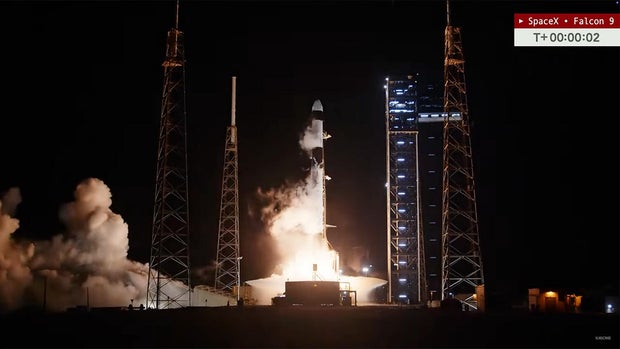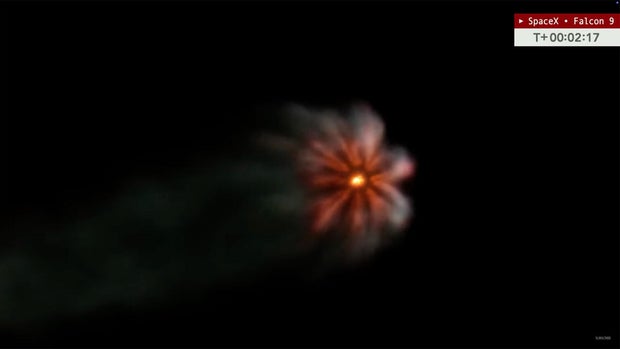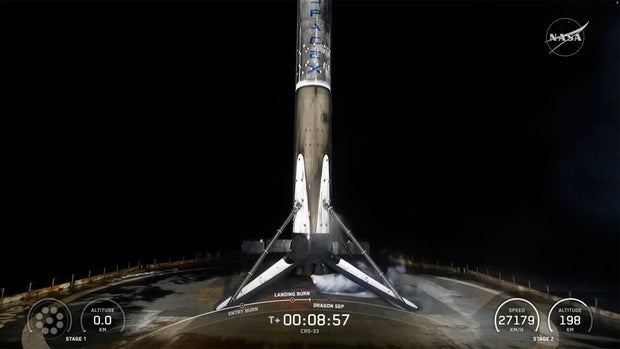SpaceX early Sunday launched its 33rd resupply mission to the International Space Station, sending up a Dragon capsule loaded with 2.5 tons of equipment and supplies along with an add-on thruster kit to help maintain the lab’s altitude.
Perched atop a workhorse Falcon 9 rocket, commercial resupply mission 33 got underway with a sky-lighting launch from the Cape Canaveral Space Force Station at 2:45 a.m. ET, climbing away on a northeasterly trajectory lined up with the space station’s orbit.
Spaceflight Now
Nine minutes and 45 seconds later, moments after the discarded first stage booster safely landed on an off-shore droneship, the Dragon was released from the rocket’s second stage, kicking off a 29-hour rendezvous with the orbiting laboratory complex.
If all goes well, the cargo ship will move in for docking at the station’s forward port at 7:30 a.m. Monday. On board: more than 2,400 pounds of crew supplies, nearly 1,000 pounds of science gear, 1,300 pounds of space station hardware, computer equipment and spacewalk gear.
The food includes the usual variety of fresh, asked-for items for the crew, including coffee, tea and more than 1,500 tortillas.
“We fly tortillas because … other breads and things like that have too many crumbs and things of that nature (that float away in weightlessness), so you can’t actually maintain it in orbit,” said Bill Spetch, ISS operations and integration manager. “Tortillas are a great substitute for that.”
On a more significant note, Heidi Parris, associate program scientist for the space station, noted that NASA will mark 25 years of continuous human presence aboard the lab in November.
Spaceflight Now
During that quarter century, she said, “we’ve hosted more than 280 residents, we’ve enabled more than 4,000 different … scientific experiments and technology demonstrations (representing) the work of over 5,000 researchers from over 110 countries around the world.”
The CRS-33 mission will bring 50 research projects to the lab, including a new study of the effects of microgravity on bone loss, a 3D metal printer to assess the capability for manufacturing spare parts and tools on demand in space and an experiment to study the effectiveness of 3D “bioprinting.”
“This investigation … is looking to create a 3D-printed implantable medical device that can support nerve regrowth after injury by bridging the gap to reconnect severed nerves while also simultaneously delivering drugs that can support nerve regeneration,” Parris said.
Of special interest to NASA is the performance of an add-on propulsion system consisting of two SpaceX Draco engines, six propellant tanks and a supply of helium to pressurize the system. The hardware is mounted in the Dragon’s open-to-space aft trunk section.
NASA/SpaceX
“The space station’s altitude slowly decays over time due to the thin amount of atmosphere still at our altitude,” Spetch said. “To counteract that drag, we must occasionally raise the altitude of the ISS.”
The Russians handle the majority of those re-boost operations, delivering the needed propellants and periodically firing thrusters aboard Progress cargo ships and the station itself.
“With the addition of the boost trunk on this mission, Dragon will also provide this ability to maintain the station’s altitude,” Spetch said. “The boost kit will help sustain the orbiting lab’s altitude starting in September with a series of burns planned periodically throughout the fall of 2025.”
The CRS-33 Dragon will remain docked to the station until December. During that time, the boost kit will provide the one-and-a-half Progress missions.
Sarah Walker, director of Dragon mission management at SpaceX, said the boost kit will provide about a quarter of the propulsion needed in one year to maintain the station’s 260-mile-high altitude. The first “burn,” expected to last about 20 minutes, is planned for Sept. 3.
Source link




